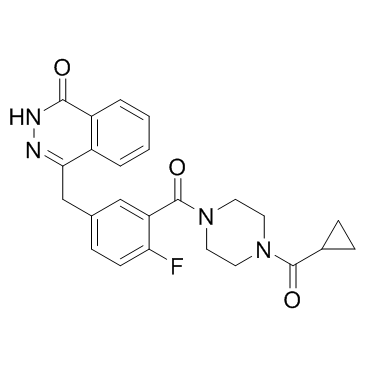763113-22-0
| Name | olaparib |
|---|---|
| Synonyms |
1(2H)-Phthalazinone, 4-[[3-[[4-(cyclopropylcarbonyl)-1-piperazinyl]carbonyl]-4-fluorophenyl]methyl]-
1-(Cyclopropylcarbonyl)-4-[5-[(3,4-dihydro-4-oxo-1-phthalazinyl)methyl]-2-fluorobenzoyl]piperazine AZD-2281 azd2281 Olaparib 4-(3-{[4-(Cyclopropylcarbonyl)-1-piperazinyl]carbonyl}-4-fluorobenzyl)-1(2H)-phthalazinone Olaparib 4-(3-{[4-(Cyclopropylcarbonyl)piperazin-1-yl]carbonyl}-4-fluorobenzyl)phthalazin-1(2H)-one Lynparza AZD2281 |
| Description | Olaparib (AZD2281;KU0059436) is a potent and oral PARP inhibitor with IC50s of 5 and 1 nM for PARP1 and PARP2, respectively. |
|---|---|
| Related Catalog | |
| Target |
PARP-2:1 nM (IC50) PARP-1:5 nM (IC50) tankyrase-1:1.5 μM (IC50) Autophagy Mitophagy |
| In Vitro | Olaparib (AZD2281) is a single digit nanomolar inhibitor of both PARP-1 and PARP-2 that shows standalone activity against BRCA1-deficient breast cancer cell lines. Olaparib is applied to SW620 cell lysates, and identified the IC50 for PARP-1 inhibition to be around 6 nM and the total ablation of PARP-1 activity to be at concentrations of 30−100 nM[1]. |
| In Vivo | Animals bearing SW620 xenografted tumors are treated with Olaparib (10 mg/kg, p.o.) in combination with Temozolomide (TMZ) (50 mg/kg, p.o.) once daily for 5 consecutive days, after which the tumors are left to grow out[1]. Olaparib increases vascular perfusion in Calu-6 tumors established in a DWC model. Administration of olaparib(50 mg/kg, p.o.) as a single agent (top panel) or in combination with radiation (bottom panel) results in an increase in fluorescence intensity in the Calu-6 tumors[2]. |
| Kinase Assay | This assay determined the ability of Olaparib to inhibit PARP-1 enzyme activity. PARP-2 activity inhibition is measured by using a variation of the PARP-1 assay in which PARP-2 protein (recombinant) is bound down by a PARP-2 specific antibody in a 96-well white-walled plate. PARP-2 activity is measured following 3H-NAD+ DNA additions. After washing, scintillant is added to measure 3H-incorporated ribosylations. For tankyrase-1, an AlphaScreen assay is developed in which HIS-tagged recombinant TANK-1 protein is incubated with biotinylated NAD+ in a 384-well ProxiPlate assay. Alpha beads are added to bind the HIS and biotin tags to create a proximity signal, whereas the inhibition of TANK-1 activity is directly proportional to the loss of this signal. All experiments are repeated at least three times[1]. |
| Cell Assay | The PF50 value is the potentiation factor, which is calculated as the ratio of the IC50 of the control growth with alkylating agent methylmethane sulfonate (MMS) divided by the IC50 of the MMS combined with the PARP inhibitor. HeLa B cells are used, and Olaparib is tested at a fixed 200 nM concentration for screening with MMS. For the testing of Olaparib on the SW620 colorectal cell line, the concentrations that are used are 1, 3, 10, 100 and 300 nM. Cell growth is assessed by the use of the sulforhodamine B (SRB) assay[1]. |
| Animal Admin | Mice[2] Mice bearing 220-250 mm3 tumors are randomized into 4 treatment groups (n=5): A; vehicle control (10% DMSO in PBS/10% 2-hydroxy-propyl-β-cyclodextrin daily for 5 days by oral gavage), B; Olaparib (50 mg/kg daily for 5 days by oral gavage), C; 10 Gy fractionated radiotherapy (2 Gy daily for 5 days), D; Olaparib and 10 Gy (5×2 Gy) fractionated radiotherapy (with olaparib given 30 min prior to each daily 2 Gy dose of radiation). Tumor volume measurements are determined daily until they reached 1000 mm3. The number of days for each individual tumor to quadruple in size from the start of the treatment (relative tumor volume×4; RTV4) is calculated for the individual tumors in each group. |
| References |
| Density | 1.4±0.1 g/cm3 |
|---|---|
| Molecular Formula | C24H23FN4O3 |
| Molecular Weight | 434.463 |
| Exact Mass | 434.175415 |
| PSA | 86.37000 |
| LogP | 0.00 |
| Index of Refraction | 1.702 |
| Storage condition | 2~8℃ |
| Hazard Codes | Xi |
|---|---|
| Risk Phrases | 22-38-37-36 |
| Safety Phrases | 24/25-37/39 |
| HS Code | 2933990090 |
| HS Code | 2933990090 |
|---|---|
| Summary | 2933990090. heterocyclic compounds with nitrogen hetero-atom(s) only. VAT:17.0%. Tax rebate rate:13.0%. . MFN tariff:6.5%. General tariff:20.0% |
